Diabetes Prevalence in Saskatchewan
VerifiedAdded on 2023/05/28
|11
|3139
|250
AI Summary
This article discusses the advent of diabetes as a major threat in Saskatchewan and its impact on the economy of the nation. It also compares the prevalence of diabetes in Saskatchewan with that of Canada as a whole.
Contribute Materials
Your contribution can guide someone’s learning journey. Share your
documents today.

Running head: DIABETES PREVALENCE IN SASKATCHEWAN
DIABETES PREVALENCE IN SASKATCHEWAN
Name of the student:
Name of the university:
Author note:
DIABETES PREVALENCE IN SASKATCHEWAN
Name of the student:
Name of the university:
Author note:
Secure Best Marks with AI Grader
Need help grading? Try our AI Grader for instant feedback on your assignments.
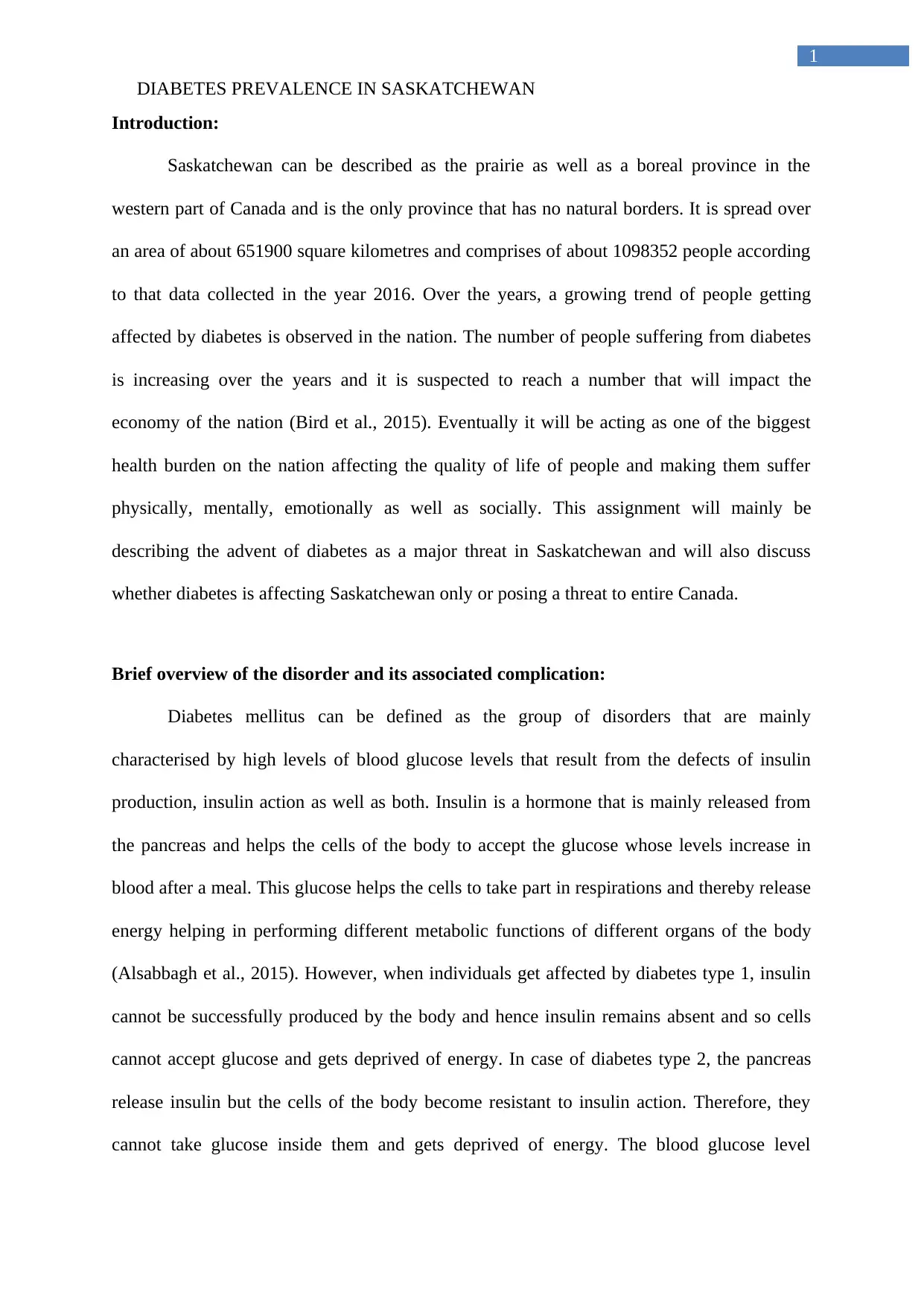
1
DIABETES PREVALENCE IN SASKATCHEWAN
Introduction:
Saskatchewan can be described as the prairie as well as a boreal province in the
western part of Canada and is the only province that has no natural borders. It is spread over
an area of about 651900 square kilometres and comprises of about 1098352 people according
to that data collected in the year 2016. Over the years, a growing trend of people getting
affected by diabetes is observed in the nation. The number of people suffering from diabetes
is increasing over the years and it is suspected to reach a number that will impact the
economy of the nation (Bird et al., 2015). Eventually it will be acting as one of the biggest
health burden on the nation affecting the quality of life of people and making them suffer
physically, mentally, emotionally as well as socially. This assignment will mainly be
describing the advent of diabetes as a major threat in Saskatchewan and will also discuss
whether diabetes is affecting Saskatchewan only or posing a threat to entire Canada.
Brief overview of the disorder and its associated complication:
Diabetes mellitus can be defined as the group of disorders that are mainly
characterised by high levels of blood glucose levels that result from the defects of insulin
production, insulin action as well as both. Insulin is a hormone that is mainly released from
the pancreas and helps the cells of the body to accept the glucose whose levels increase in
blood after a meal. This glucose helps the cells to take part in respirations and thereby release
energy helping in performing different metabolic functions of different organs of the body
(Alsabbagh et al., 2015). However, when individuals get affected by diabetes type 1, insulin
cannot be successfully produced by the body and hence insulin remains absent and so cells
cannot accept glucose and gets deprived of energy. In case of diabetes type 2, the pancreas
release insulin but the cells of the body become resistant to insulin action. Therefore, they
cannot take glucose inside them and gets deprived of energy. The blood glucose level
DIABETES PREVALENCE IN SASKATCHEWAN
Introduction:
Saskatchewan can be described as the prairie as well as a boreal province in the
western part of Canada and is the only province that has no natural borders. It is spread over
an area of about 651900 square kilometres and comprises of about 1098352 people according
to that data collected in the year 2016. Over the years, a growing trend of people getting
affected by diabetes is observed in the nation. The number of people suffering from diabetes
is increasing over the years and it is suspected to reach a number that will impact the
economy of the nation (Bird et al., 2015). Eventually it will be acting as one of the biggest
health burden on the nation affecting the quality of life of people and making them suffer
physically, mentally, emotionally as well as socially. This assignment will mainly be
describing the advent of diabetes as a major threat in Saskatchewan and will also discuss
whether diabetes is affecting Saskatchewan only or posing a threat to entire Canada.
Brief overview of the disorder and its associated complication:
Diabetes mellitus can be defined as the group of disorders that are mainly
characterised by high levels of blood glucose levels that result from the defects of insulin
production, insulin action as well as both. Insulin is a hormone that is mainly released from
the pancreas and helps the cells of the body to accept the glucose whose levels increase in
blood after a meal. This glucose helps the cells to take part in respirations and thereby release
energy helping in performing different metabolic functions of different organs of the body
(Alsabbagh et al., 2015). However, when individuals get affected by diabetes type 1, insulin
cannot be successfully produced by the body and hence insulin remains absent and so cells
cannot accept glucose and gets deprived of energy. In case of diabetes type 2, the pancreas
release insulin but the cells of the body become resistant to insulin action. Therefore, they
cannot take glucose inside them and gets deprived of energy. The blood glucose level
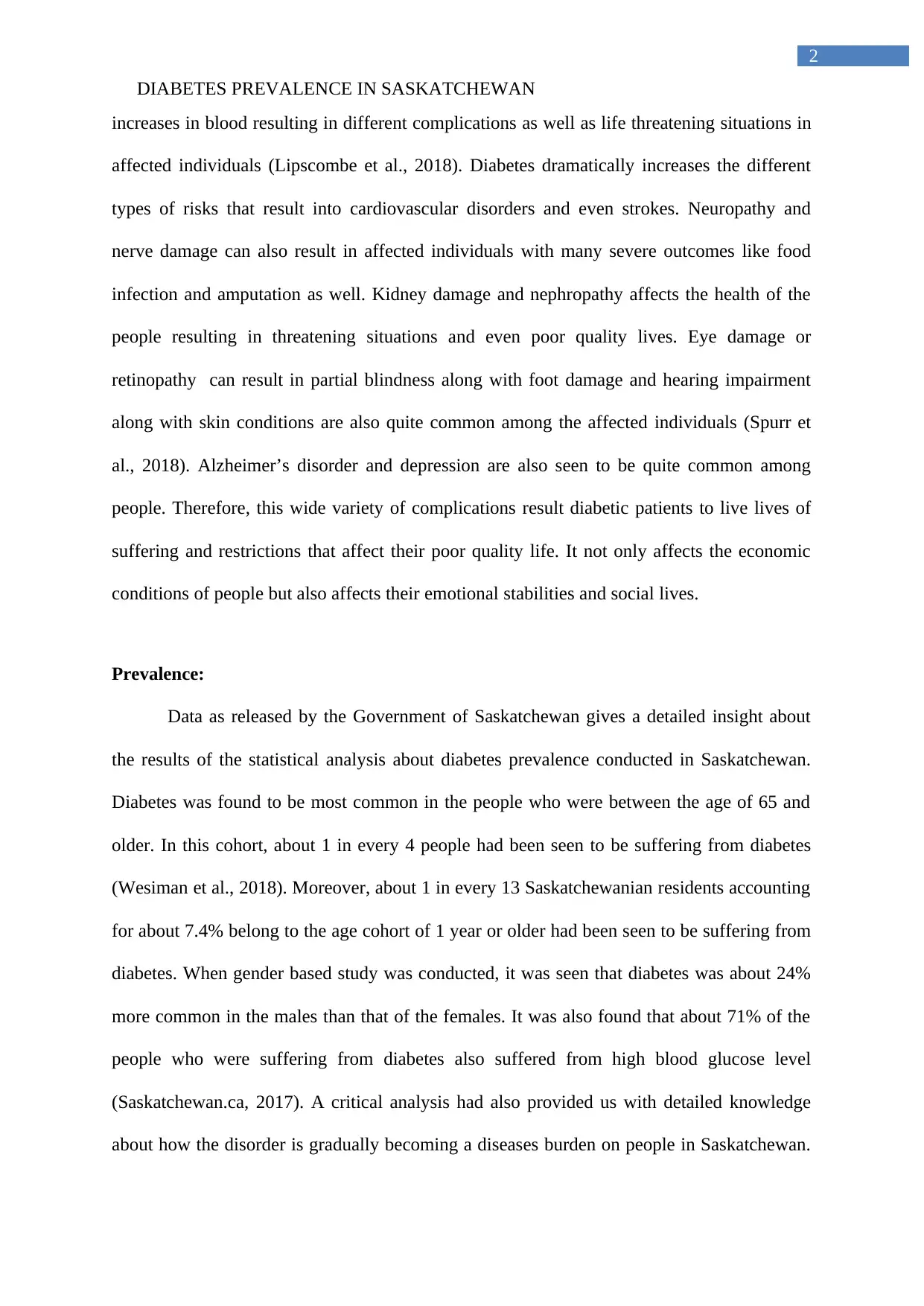
2
DIABETES PREVALENCE IN SASKATCHEWAN
increases in blood resulting in different complications as well as life threatening situations in
affected individuals (Lipscombe et al., 2018). Diabetes dramatically increases the different
types of risks that result into cardiovascular disorders and even strokes. Neuropathy and
nerve damage can also result in affected individuals with many severe outcomes like food
infection and amputation as well. Kidney damage and nephropathy affects the health of the
people resulting in threatening situations and even poor quality lives. Eye damage or
retinopathy can result in partial blindness along with foot damage and hearing impairment
along with skin conditions are also quite common among the affected individuals (Spurr et
al., 2018). Alzheimer’s disorder and depression are also seen to be quite common among
people. Therefore, this wide variety of complications result diabetic patients to live lives of
suffering and restrictions that affect their poor quality life. It not only affects the economic
conditions of people but also affects their emotional stabilities and social lives.
Prevalence:
Data as released by the Government of Saskatchewan gives a detailed insight about
the results of the statistical analysis about diabetes prevalence conducted in Saskatchewan.
Diabetes was found to be most common in the people who were between the age of 65 and
older. In this cohort, about 1 in every 4 people had been seen to be suffering from diabetes
(Wesiman et al., 2018). Moreover, about 1 in every 13 Saskatchewanian residents accounting
for about 7.4% belong to the age cohort of 1 year or older had been seen to be suffering from
diabetes. When gender based study was conducted, it was seen that diabetes was about 24%
more common in the males than that of the females. It was also found that about 71% of the
people who were suffering from diabetes also suffered from high blood glucose level
(Saskatchewan.ca, 2017). A critical analysis had also provided us with detailed knowledge
about how the disorder is gradually becoming a diseases burden on people in Saskatchewan.
DIABETES PREVALENCE IN SASKATCHEWAN
increases in blood resulting in different complications as well as life threatening situations in
affected individuals (Lipscombe et al., 2018). Diabetes dramatically increases the different
types of risks that result into cardiovascular disorders and even strokes. Neuropathy and
nerve damage can also result in affected individuals with many severe outcomes like food
infection and amputation as well. Kidney damage and nephropathy affects the health of the
people resulting in threatening situations and even poor quality lives. Eye damage or
retinopathy can result in partial blindness along with foot damage and hearing impairment
along with skin conditions are also quite common among the affected individuals (Spurr et
al., 2018). Alzheimer’s disorder and depression are also seen to be quite common among
people. Therefore, this wide variety of complications result diabetic patients to live lives of
suffering and restrictions that affect their poor quality life. It not only affects the economic
conditions of people but also affects their emotional stabilities and social lives.
Prevalence:
Data as released by the Government of Saskatchewan gives a detailed insight about
the results of the statistical analysis about diabetes prevalence conducted in Saskatchewan.
Diabetes was found to be most common in the people who were between the age of 65 and
older. In this cohort, about 1 in every 4 people had been seen to be suffering from diabetes
(Wesiman et al., 2018). Moreover, about 1 in every 13 Saskatchewanian residents accounting
for about 7.4% belong to the age cohort of 1 year or older had been seen to be suffering from
diabetes. When gender based study was conducted, it was seen that diabetes was about 24%
more common in the males than that of the females. It was also found that about 71% of the
people who were suffering from diabetes also suffered from high blood glucose level
(Saskatchewan.ca, 2017). A critical analysis had also provided us with detailed knowledge
about how the disorder is gradually becoming a diseases burden on people in Saskatchewan.
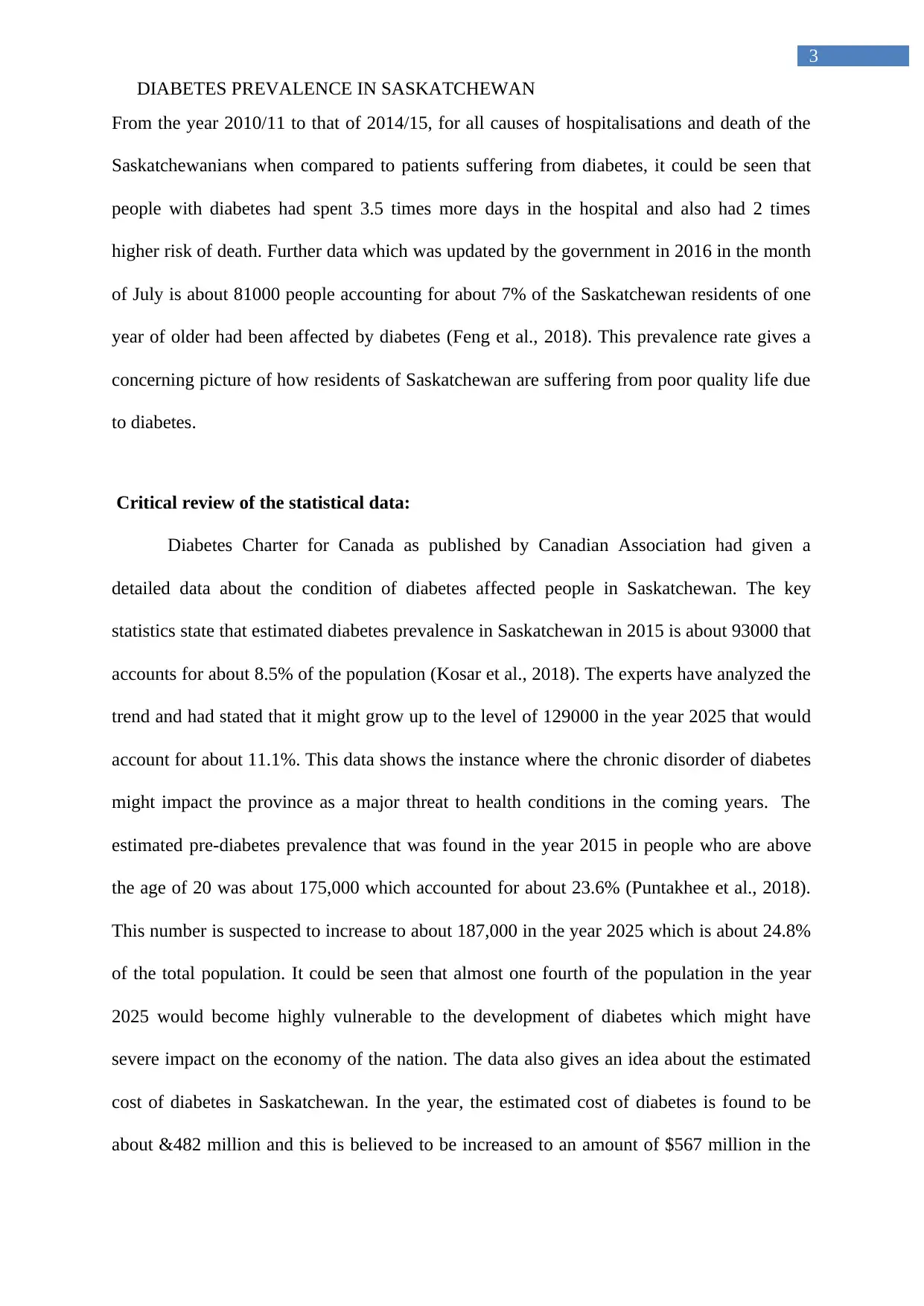
3
DIABETES PREVALENCE IN SASKATCHEWAN
From the year 2010/11 to that of 2014/15, for all causes of hospitalisations and death of the
Saskatchewanians when compared to patients suffering from diabetes, it could be seen that
people with diabetes had spent 3.5 times more days in the hospital and also had 2 times
higher risk of death. Further data which was updated by the government in 2016 in the month
of July is about 81000 people accounting for about 7% of the Saskatchewan residents of one
year of older had been affected by diabetes (Feng et al., 2018). This prevalence rate gives a
concerning picture of how residents of Saskatchewan are suffering from poor quality life due
to diabetes.
Critical review of the statistical data:
Diabetes Charter for Canada as published by Canadian Association had given a
detailed data about the condition of diabetes affected people in Saskatchewan. The key
statistics state that estimated diabetes prevalence in Saskatchewan in 2015 is about 93000 that
accounts for about 8.5% of the population (Kosar et al., 2018). The experts have analyzed the
trend and had stated that it might grow up to the level of 129000 in the year 2025 that would
account for about 11.1%. This data shows the instance where the chronic disorder of diabetes
might impact the province as a major threat to health conditions in the coming years. The
estimated pre-diabetes prevalence that was found in the year 2015 in people who are above
the age of 20 was about 175,000 which accounted for about 23.6% (Puntakhee et al., 2018).
This number is suspected to increase to about 187,000 in the year 2025 which is about 24.8%
of the total population. It could be seen that almost one fourth of the population in the year
2025 would become highly vulnerable to the development of diabetes which might have
severe impact on the economy of the nation. The data also gives an idea about the estimated
cost of diabetes in Saskatchewan. In the year, the estimated cost of diabetes is found to be
about &482 million and this is believed to be increased to an amount of $567 million in the
DIABETES PREVALENCE IN SASKATCHEWAN
From the year 2010/11 to that of 2014/15, for all causes of hospitalisations and death of the
Saskatchewanians when compared to patients suffering from diabetes, it could be seen that
people with diabetes had spent 3.5 times more days in the hospital and also had 2 times
higher risk of death. Further data which was updated by the government in 2016 in the month
of July is about 81000 people accounting for about 7% of the Saskatchewan residents of one
year of older had been affected by diabetes (Feng et al., 2018). This prevalence rate gives a
concerning picture of how residents of Saskatchewan are suffering from poor quality life due
to diabetes.
Critical review of the statistical data:
Diabetes Charter for Canada as published by Canadian Association had given a
detailed data about the condition of diabetes affected people in Saskatchewan. The key
statistics state that estimated diabetes prevalence in Saskatchewan in 2015 is about 93000 that
accounts for about 8.5% of the population (Kosar et al., 2018). The experts have analyzed the
trend and had stated that it might grow up to the level of 129000 in the year 2025 that would
account for about 11.1%. This data shows the instance where the chronic disorder of diabetes
might impact the province as a major threat to health conditions in the coming years. The
estimated pre-diabetes prevalence that was found in the year 2015 in people who are above
the age of 20 was about 175,000 which accounted for about 23.6% (Puntakhee et al., 2018).
This number is suspected to increase to about 187,000 in the year 2025 which is about 24.8%
of the total population. It could be seen that almost one fourth of the population in the year
2025 would become highly vulnerable to the development of diabetes which might have
severe impact on the economy of the nation. The data also gives an idea about the estimated
cost of diabetes in Saskatchewan. In the year, the estimated cost of diabetes is found to be
about &482 million and this is believed to be increased to an amount of $567 million in the
Secure Best Marks with AI Grader
Need help grading? Try our AI Grader for instant feedback on your assignments.
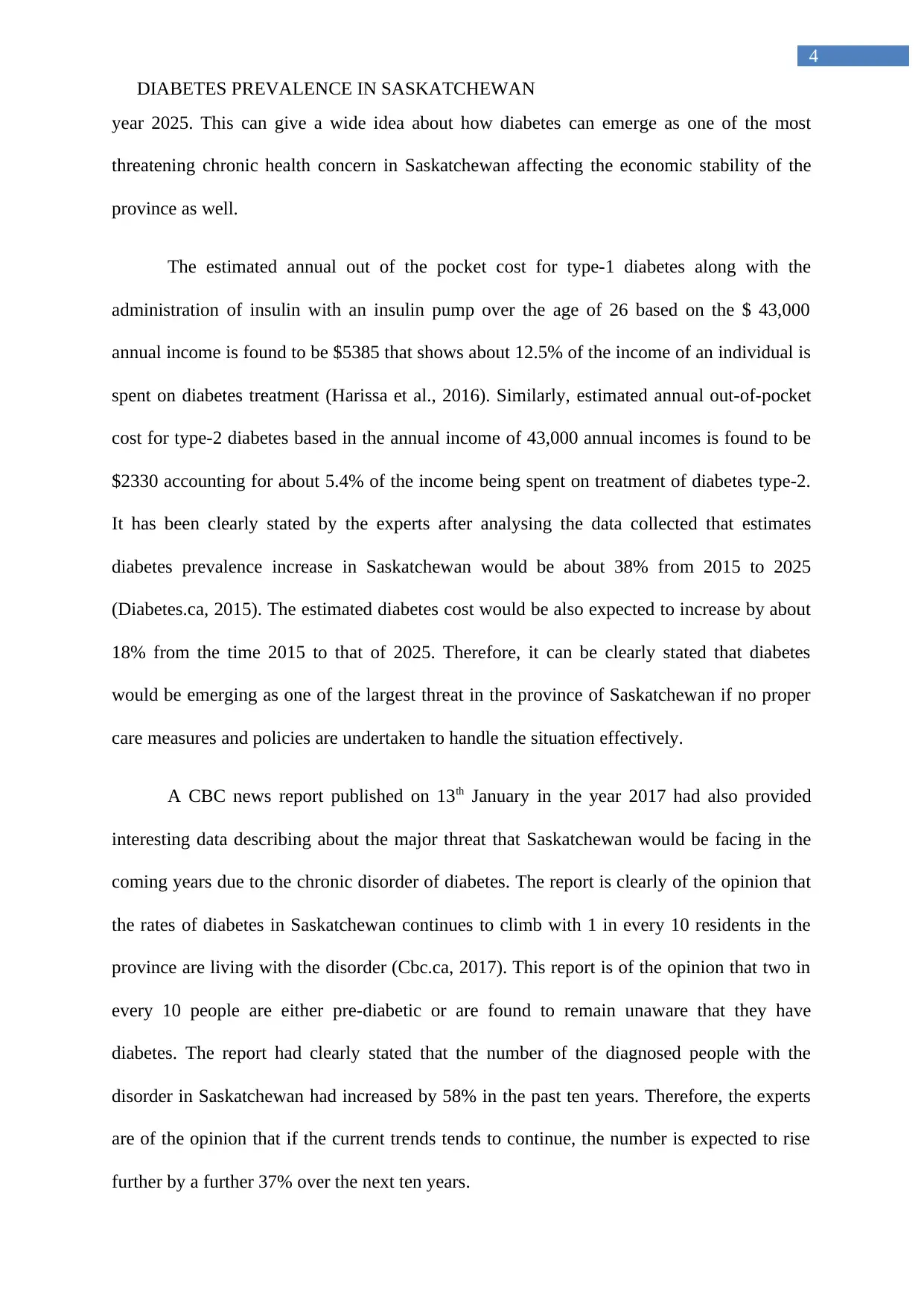
4
DIABETES PREVALENCE IN SASKATCHEWAN
year 2025. This can give a wide idea about how diabetes can emerge as one of the most
threatening chronic health concern in Saskatchewan affecting the economic stability of the
province as well.
The estimated annual out of the pocket cost for type-1 diabetes along with the
administration of insulin with an insulin pump over the age of 26 based on the $ 43,000
annual income is found to be $5385 that shows about 12.5% of the income of an individual is
spent on diabetes treatment (Harissa et al., 2016). Similarly, estimated annual out-of-pocket
cost for type-2 diabetes based in the annual income of 43,000 annual incomes is found to be
$2330 accounting for about 5.4% of the income being spent on treatment of diabetes type-2.
It has been clearly stated by the experts after analysing the data collected that estimates
diabetes prevalence increase in Saskatchewan would be about 38% from 2015 to 2025
(Diabetes.ca, 2015). The estimated diabetes cost would be also expected to increase by about
18% from the time 2015 to that of 2025. Therefore, it can be clearly stated that diabetes
would be emerging as one of the largest threat in the province of Saskatchewan if no proper
care measures and policies are undertaken to handle the situation effectively.
A CBC news report published on 13th January in the year 2017 had also provided
interesting data describing about the major threat that Saskatchewan would be facing in the
coming years due to the chronic disorder of diabetes. The report is clearly of the opinion that
the rates of diabetes in Saskatchewan continues to climb with 1 in every 10 residents in the
province are living with the disorder (Cbc.ca, 2017). This report is of the opinion that two in
every 10 people are either pre-diabetic or are found to remain unaware that they have
diabetes. The report had clearly stated that the number of the diagnosed people with the
disorder in Saskatchewan had increased by 58% in the past ten years. Therefore, the experts
are of the opinion that if the current trends tends to continue, the number is expected to rise
further by a further 37% over the next ten years.
DIABETES PREVALENCE IN SASKATCHEWAN
year 2025. This can give a wide idea about how diabetes can emerge as one of the most
threatening chronic health concern in Saskatchewan affecting the economic stability of the
province as well.
The estimated annual out of the pocket cost for type-1 diabetes along with the
administration of insulin with an insulin pump over the age of 26 based on the $ 43,000
annual income is found to be $5385 that shows about 12.5% of the income of an individual is
spent on diabetes treatment (Harissa et al., 2016). Similarly, estimated annual out-of-pocket
cost for type-2 diabetes based in the annual income of 43,000 annual incomes is found to be
$2330 accounting for about 5.4% of the income being spent on treatment of diabetes type-2.
It has been clearly stated by the experts after analysing the data collected that estimates
diabetes prevalence increase in Saskatchewan would be about 38% from 2015 to 2025
(Diabetes.ca, 2015). The estimated diabetes cost would be also expected to increase by about
18% from the time 2015 to that of 2025. Therefore, it can be clearly stated that diabetes
would be emerging as one of the largest threat in the province of Saskatchewan if no proper
care measures and policies are undertaken to handle the situation effectively.
A CBC news report published on 13th January in the year 2017 had also provided
interesting data describing about the major threat that Saskatchewan would be facing in the
coming years due to the chronic disorder of diabetes. The report is clearly of the opinion that
the rates of diabetes in Saskatchewan continues to climb with 1 in every 10 residents in the
province are living with the disorder (Cbc.ca, 2017). This report is of the opinion that two in
every 10 people are either pre-diabetic or are found to remain unaware that they have
diabetes. The report had clearly stated that the number of the diagnosed people with the
disorder in Saskatchewan had increased by 58% in the past ten years. Therefore, the experts
are of the opinion that if the current trends tends to continue, the number is expected to rise
further by a further 37% over the next ten years.
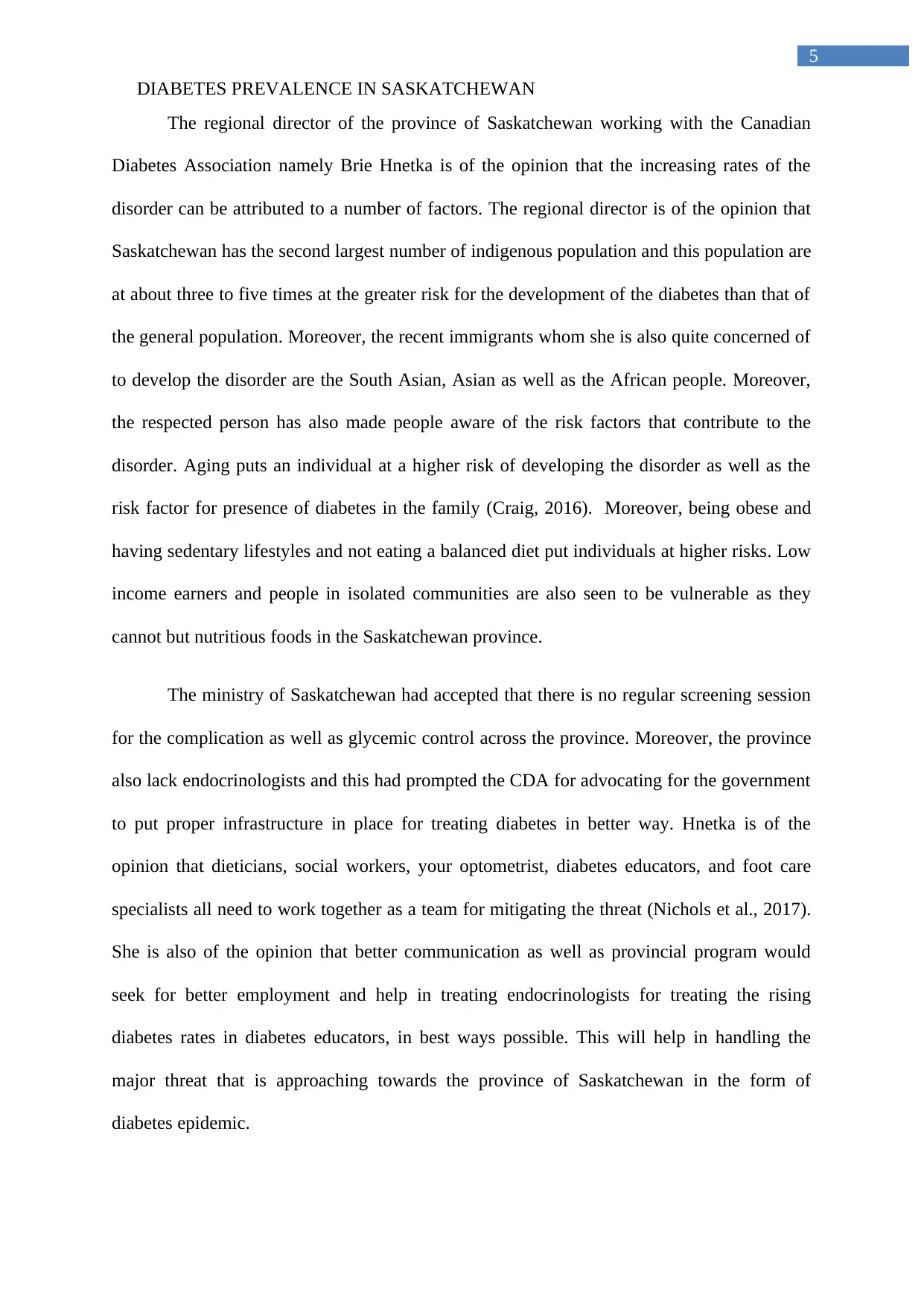
5
DIABETES PREVALENCE IN SASKATCHEWAN
The regional director of the province of Saskatchewan working with the Canadian
Diabetes Association namely Brie Hnetka is of the opinion that the increasing rates of the
disorder can be attributed to a number of factors. The regional director is of the opinion that
Saskatchewan has the second largest number of indigenous population and this population are
at about three to five times at the greater risk for the development of the diabetes than that of
the general population. Moreover, the recent immigrants whom she is also quite concerned of
to develop the disorder are the South Asian, Asian as well as the African people. Moreover,
the respected person has also made people aware of the risk factors that contribute to the
disorder. Aging puts an individual at a higher risk of developing the disorder as well as the
risk factor for presence of diabetes in the family (Craig, 2016). Moreover, being obese and
having sedentary lifestyles and not eating a balanced diet put individuals at higher risks. Low
income earners and people in isolated communities are also seen to be vulnerable as they
cannot but nutritious foods in the Saskatchewan province.
The ministry of Saskatchewan had accepted that there is no regular screening session
for the complication as well as glycemic control across the province. Moreover, the province
also lack endocrinologists and this had prompted the CDA for advocating for the government
to put proper infrastructure in place for treating diabetes in better way. Hnetka is of the
opinion that dieticians, social workers, your optometrist, diabetes educators, and foot care
specialists all need to work together as a team for mitigating the threat (Nichols et al., 2017).
She is also of the opinion that better communication as well as provincial program would
seek for better employment and help in treating endocrinologists for treating the rising
diabetes rates in diabetes educators, in best ways possible. This will help in handling the
major threat that is approaching towards the province of Saskatchewan in the form of
diabetes epidemic.
DIABETES PREVALENCE IN SASKATCHEWAN
The regional director of the province of Saskatchewan working with the Canadian
Diabetes Association namely Brie Hnetka is of the opinion that the increasing rates of the
disorder can be attributed to a number of factors. The regional director is of the opinion that
Saskatchewan has the second largest number of indigenous population and this population are
at about three to five times at the greater risk for the development of the diabetes than that of
the general population. Moreover, the recent immigrants whom she is also quite concerned of
to develop the disorder are the South Asian, Asian as well as the African people. Moreover,
the respected person has also made people aware of the risk factors that contribute to the
disorder. Aging puts an individual at a higher risk of developing the disorder as well as the
risk factor for presence of diabetes in the family (Craig, 2016). Moreover, being obese and
having sedentary lifestyles and not eating a balanced diet put individuals at higher risks. Low
income earners and people in isolated communities are also seen to be vulnerable as they
cannot but nutritious foods in the Saskatchewan province.
The ministry of Saskatchewan had accepted that there is no regular screening session
for the complication as well as glycemic control across the province. Moreover, the province
also lack endocrinologists and this had prompted the CDA for advocating for the government
to put proper infrastructure in place for treating diabetes in better way. Hnetka is of the
opinion that dieticians, social workers, your optometrist, diabetes educators, and foot care
specialists all need to work together as a team for mitigating the threat (Nichols et al., 2017).
She is also of the opinion that better communication as well as provincial program would
seek for better employment and help in treating endocrinologists for treating the rising
diabetes rates in diabetes educators, in best ways possible. This will help in handling the
major threat that is approaching towards the province of Saskatchewan in the form of
diabetes epidemic.
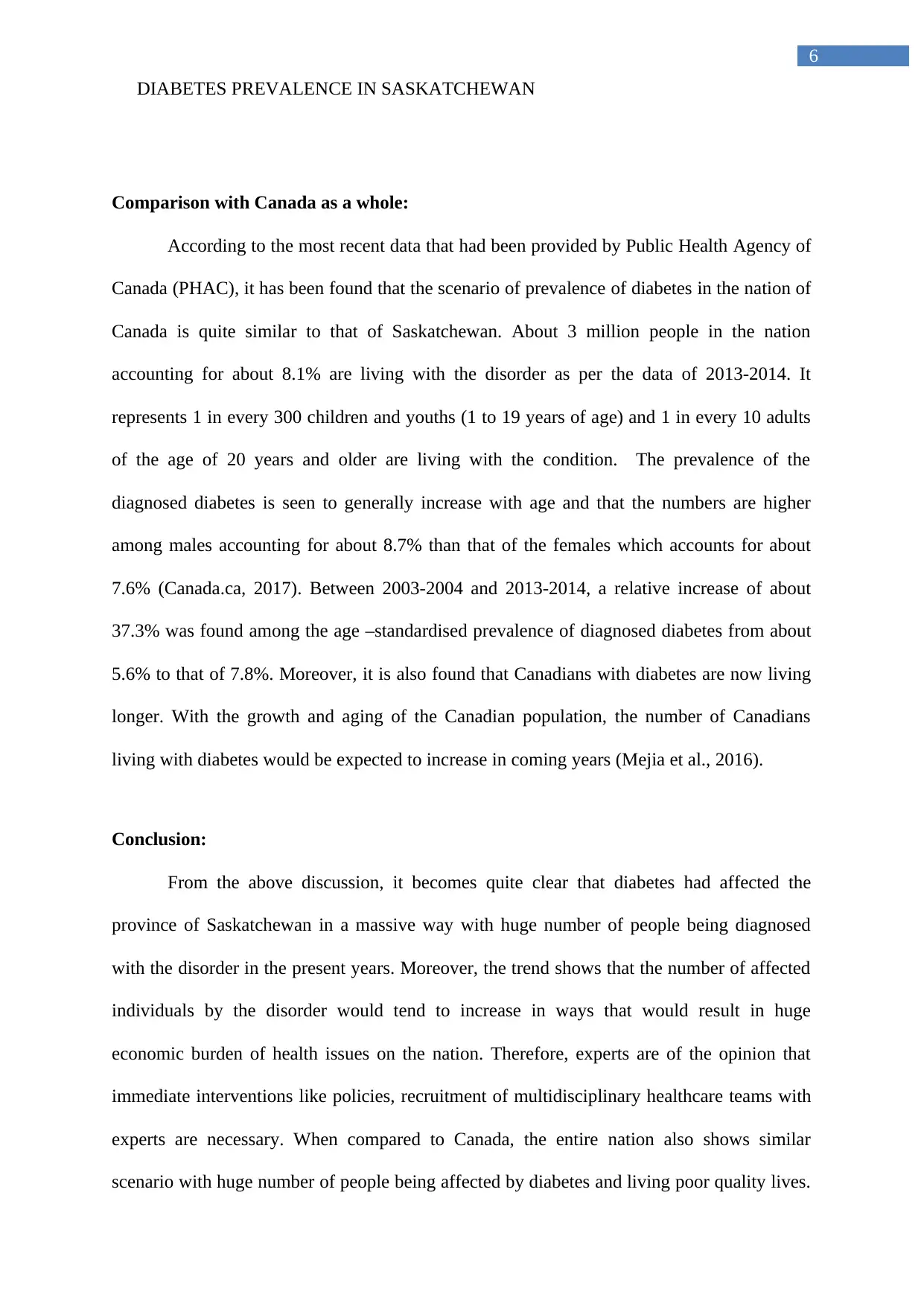
6
DIABETES PREVALENCE IN SASKATCHEWAN
Comparison with Canada as a whole:
According to the most recent data that had been provided by Public Health Agency of
Canada (PHAC), it has been found that the scenario of prevalence of diabetes in the nation of
Canada is quite similar to that of Saskatchewan. About 3 million people in the nation
accounting for about 8.1% are living with the disorder as per the data of 2013-2014. It
represents 1 in every 300 children and youths (1 to 19 years of age) and 1 in every 10 adults
of the age of 20 years and older are living with the condition. The prevalence of the
diagnosed diabetes is seen to generally increase with age and that the numbers are higher
among males accounting for about 8.7% than that of the females which accounts for about
7.6% (Canada.ca, 2017). Between 2003-2004 and 2013-2014, a relative increase of about
37.3% was found among the age –standardised prevalence of diagnosed diabetes from about
5.6% to that of 7.8%. Moreover, it is also found that Canadians with diabetes are now living
longer. With the growth and aging of the Canadian population, the number of Canadians
living with diabetes would be expected to increase in coming years (Mejia et al., 2016).
Conclusion:
From the above discussion, it becomes quite clear that diabetes had affected the
province of Saskatchewan in a massive way with huge number of people being diagnosed
with the disorder in the present years. Moreover, the trend shows that the number of affected
individuals by the disorder would tend to increase in ways that would result in huge
economic burden of health issues on the nation. Therefore, experts are of the opinion that
immediate interventions like policies, recruitment of multidisciplinary healthcare teams with
experts are necessary. When compared to Canada, the entire nation also shows similar
scenario with huge number of people being affected by diabetes and living poor quality lives.
DIABETES PREVALENCE IN SASKATCHEWAN
Comparison with Canada as a whole:
According to the most recent data that had been provided by Public Health Agency of
Canada (PHAC), it has been found that the scenario of prevalence of diabetes in the nation of
Canada is quite similar to that of Saskatchewan. About 3 million people in the nation
accounting for about 8.1% are living with the disorder as per the data of 2013-2014. It
represents 1 in every 300 children and youths (1 to 19 years of age) and 1 in every 10 adults
of the age of 20 years and older are living with the condition. The prevalence of the
diagnosed diabetes is seen to generally increase with age and that the numbers are higher
among males accounting for about 8.7% than that of the females which accounts for about
7.6% (Canada.ca, 2017). Between 2003-2004 and 2013-2014, a relative increase of about
37.3% was found among the age –standardised prevalence of diagnosed diabetes from about
5.6% to that of 7.8%. Moreover, it is also found that Canadians with diabetes are now living
longer. With the growth and aging of the Canadian population, the number of Canadians
living with diabetes would be expected to increase in coming years (Mejia et al., 2016).
Conclusion:
From the above discussion, it becomes quite clear that diabetes had affected the
province of Saskatchewan in a massive way with huge number of people being diagnosed
with the disorder in the present years. Moreover, the trend shows that the number of affected
individuals by the disorder would tend to increase in ways that would result in huge
economic burden of health issues on the nation. Therefore, experts are of the opinion that
immediate interventions like policies, recruitment of multidisciplinary healthcare teams with
experts are necessary. When compared to Canada, the entire nation also shows similar
scenario with huge number of people being affected by diabetes and living poor quality lives.
Paraphrase This Document
Need a fresh take? Get an instant paraphrase of this document with our AI Paraphraser

7
DIABETES PREVALENCE IN SASKATCHEWAN
Hence, healthcare departments of the government should undertake immediate interventions
and strategies that would help in preventing the threat from affecting lives of the nation.
DIABETES PREVALENCE IN SASKATCHEWAN
Hence, healthcare departments of the government should undertake immediate interventions
and strategies that would help in preventing the threat from affecting lives of the nation.

8
DIABETES PREVALENCE IN SASKATCHEWAN
References:
Alsabbagh, M. W., Mansell, K., Lix, L. M., Teare, G., Shevchuk, Y., Lu, X., ... & Blackburn,
D. F. (2015). Trends in prevalence, incidence and pharmacologic management of
diabetes mellitus among seniors newly admitted to long-term care facilities in
Saskatchewan between 2003 and 2011. Canadian journal of diabetes, 39(2), 138-145.
Bird, Y., Lemstra, M., Rogers, M., & Moraros, J. (2015). The relationship between
socioeconomic status/income and prevalence of diabetes and associated conditions: A
cross-sectional population-based study in Saskatchewan, Canada. International
journal for equity in health, 14(1), 93.
Canada.ca (2017) Diabetes in Canada, Public Health Agency of Canada Retrieved from:
https://www.canada.ca/en/public-health/services/publications/diseases-conditions/
diabetes-canada-highlights-chronic-disease-surveillance-system.html (accessed on 8th
December, 2018)
Cbc.ca (2017) Diabetes rates in Saskatchewan continue to climb, CBC news report –online,
Retrieved from: https://www.cbc.ca/news/canada/saskatchewan/diabetes-rates-
saskatchewan-climb-1.3933762 (accessed on 8th December, 2018)
Craig, (2016) Saskatchewan diabetes rate more than doubles in the last decade, Global News,
retrieved from: https://globalnews.ca/news/2625773/saskatchewan-diabetes-rate-
more-than-doubles-in-the-last-decade/(accessed on 8th December, 2018)
Diabetes.ca (2015) Diabetes Charter For Canada, Canadian Diabetes Association, Retrieved
from: https://www.diabetes.ca/getmedia/edb0e156-2cb7-4444-a3ab-39b526bdb347/
diabetes-charter-backgrounder-saskatchewan-english.pdf.aspx
DIABETES PREVALENCE IN SASKATCHEWAN
References:
Alsabbagh, M. W., Mansell, K., Lix, L. M., Teare, G., Shevchuk, Y., Lu, X., ... & Blackburn,
D. F. (2015). Trends in prevalence, incidence and pharmacologic management of
diabetes mellitus among seniors newly admitted to long-term care facilities in
Saskatchewan between 2003 and 2011. Canadian journal of diabetes, 39(2), 138-145.
Bird, Y., Lemstra, M., Rogers, M., & Moraros, J. (2015). The relationship between
socioeconomic status/income and prevalence of diabetes and associated conditions: A
cross-sectional population-based study in Saskatchewan, Canada. International
journal for equity in health, 14(1), 93.
Canada.ca (2017) Diabetes in Canada, Public Health Agency of Canada Retrieved from:
https://www.canada.ca/en/public-health/services/publications/diseases-conditions/
diabetes-canada-highlights-chronic-disease-surveillance-system.html (accessed on 8th
December, 2018)
Cbc.ca (2017) Diabetes rates in Saskatchewan continue to climb, CBC news report –online,
Retrieved from: https://www.cbc.ca/news/canada/saskatchewan/diabetes-rates-
saskatchewan-climb-1.3933762 (accessed on 8th December, 2018)
Craig, (2016) Saskatchewan diabetes rate more than doubles in the last decade, Global News,
retrieved from: https://globalnews.ca/news/2625773/saskatchewan-diabetes-rate-
more-than-doubles-in-the-last-decade/(accessed on 8th December, 2018)
Diabetes.ca (2015) Diabetes Charter For Canada, Canadian Diabetes Association, Retrieved
from: https://www.diabetes.ca/getmedia/edb0e156-2cb7-4444-a3ab-39b526bdb347/
diabetes-charter-backgrounder-saskatchewan-english.pdf.aspx
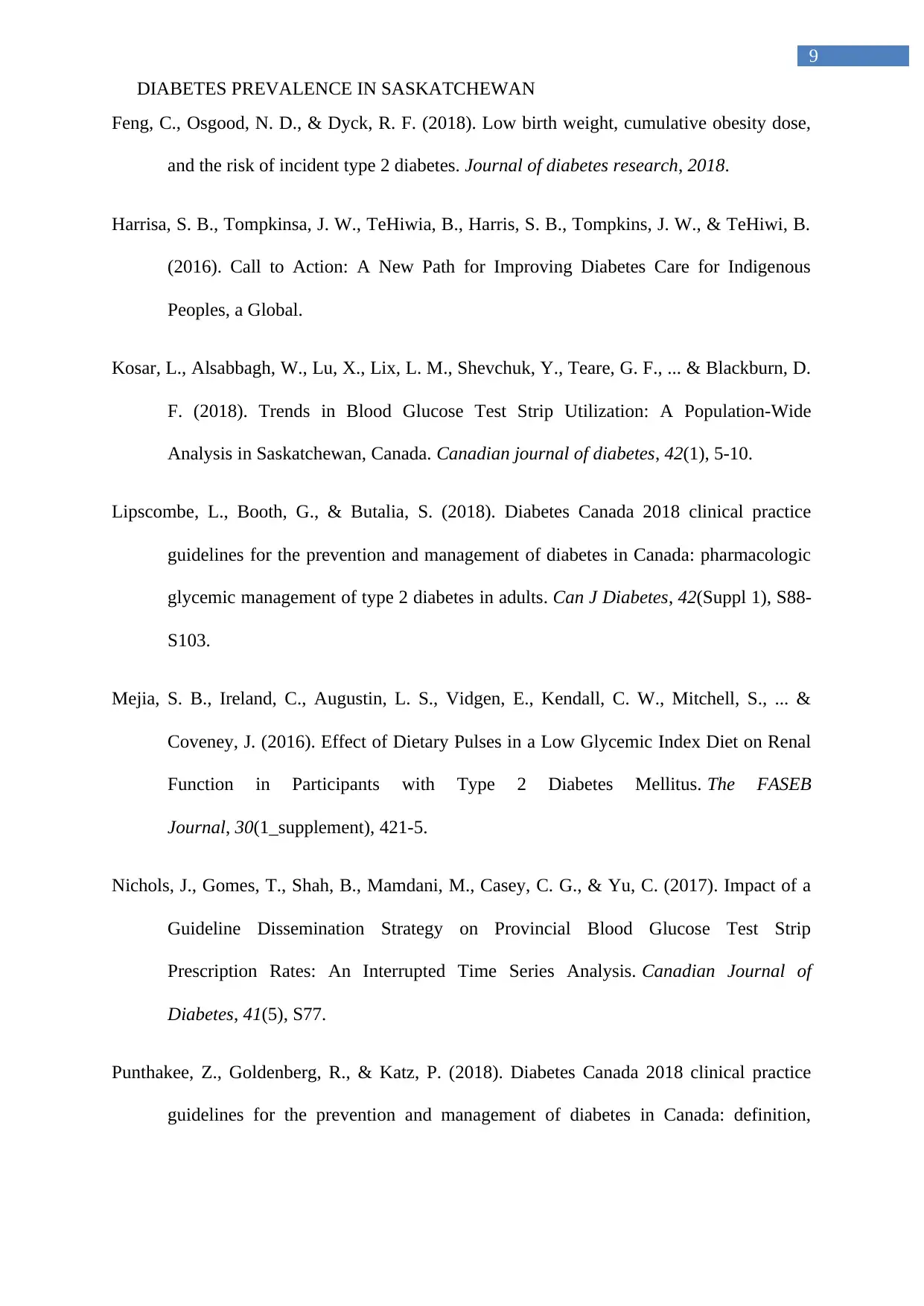
9
DIABETES PREVALENCE IN SASKATCHEWAN
Feng, C., Osgood, N. D., & Dyck, R. F. (2018). Low birth weight, cumulative obesity dose,
and the risk of incident type 2 diabetes. Journal of diabetes research, 2018.
Harrisa, S. B., Tompkinsa, J. W., TeHiwia, B., Harris, S. B., Tompkins, J. W., & TeHiwi, B.
(2016). Call to Action: A New Path for Improving Diabetes Care for Indigenous
Peoples, a Global.
Kosar, L., Alsabbagh, W., Lu, X., Lix, L. M., Shevchuk, Y., Teare, G. F., ... & Blackburn, D.
F. (2018). Trends in Blood Glucose Test Strip Utilization: A Population-Wide
Analysis in Saskatchewan, Canada. Canadian journal of diabetes, 42(1), 5-10.
Lipscombe, L., Booth, G., & Butalia, S. (2018). Diabetes Canada 2018 clinical practice
guidelines for the prevention and management of diabetes in Canada: pharmacologic
glycemic management of type 2 diabetes in adults. Can J Diabetes, 42(Suppl 1), S88-
S103.
Mejia, S. B., Ireland, C., Augustin, L. S., Vidgen, E., Kendall, C. W., Mitchell, S., ... &
Coveney, J. (2016). Effect of Dietary Pulses in a Low Glycemic Index Diet on Renal
Function in Participants with Type 2 Diabetes Mellitus. The FASEB
Journal, 30(1_supplement), 421-5.
Nichols, J., Gomes, T., Shah, B., Mamdani, M., Casey, C. G., & Yu, C. (2017). Impact of a
Guideline Dissemination Strategy on Provincial Blood Glucose Test Strip
Prescription Rates: An Interrupted Time Series Analysis. Canadian Journal of
Diabetes, 41(5), S77.
Punthakee, Z., Goldenberg, R., & Katz, P. (2018). Diabetes Canada 2018 clinical practice
guidelines for the prevention and management of diabetes in Canada: definition,
DIABETES PREVALENCE IN SASKATCHEWAN
Feng, C., Osgood, N. D., & Dyck, R. F. (2018). Low birth weight, cumulative obesity dose,
and the risk of incident type 2 diabetes. Journal of diabetes research, 2018.
Harrisa, S. B., Tompkinsa, J. W., TeHiwia, B., Harris, S. B., Tompkins, J. W., & TeHiwi, B.
(2016). Call to Action: A New Path for Improving Diabetes Care for Indigenous
Peoples, a Global.
Kosar, L., Alsabbagh, W., Lu, X., Lix, L. M., Shevchuk, Y., Teare, G. F., ... & Blackburn, D.
F. (2018). Trends in Blood Glucose Test Strip Utilization: A Population-Wide
Analysis in Saskatchewan, Canada. Canadian journal of diabetes, 42(1), 5-10.
Lipscombe, L., Booth, G., & Butalia, S. (2018). Diabetes Canada 2018 clinical practice
guidelines for the prevention and management of diabetes in Canada: pharmacologic
glycemic management of type 2 diabetes in adults. Can J Diabetes, 42(Suppl 1), S88-
S103.
Mejia, S. B., Ireland, C., Augustin, L. S., Vidgen, E., Kendall, C. W., Mitchell, S., ... &
Coveney, J. (2016). Effect of Dietary Pulses in a Low Glycemic Index Diet on Renal
Function in Participants with Type 2 Diabetes Mellitus. The FASEB
Journal, 30(1_supplement), 421-5.
Nichols, J., Gomes, T., Shah, B., Mamdani, M., Casey, C. G., & Yu, C. (2017). Impact of a
Guideline Dissemination Strategy on Provincial Blood Glucose Test Strip
Prescription Rates: An Interrupted Time Series Analysis. Canadian Journal of
Diabetes, 41(5), S77.
Punthakee, Z., Goldenberg, R., & Katz, P. (2018). Diabetes Canada 2018 clinical practice
guidelines for the prevention and management of diabetes in Canada: definition,
Secure Best Marks with AI Grader
Need help grading? Try our AI Grader for instant feedback on your assignments.
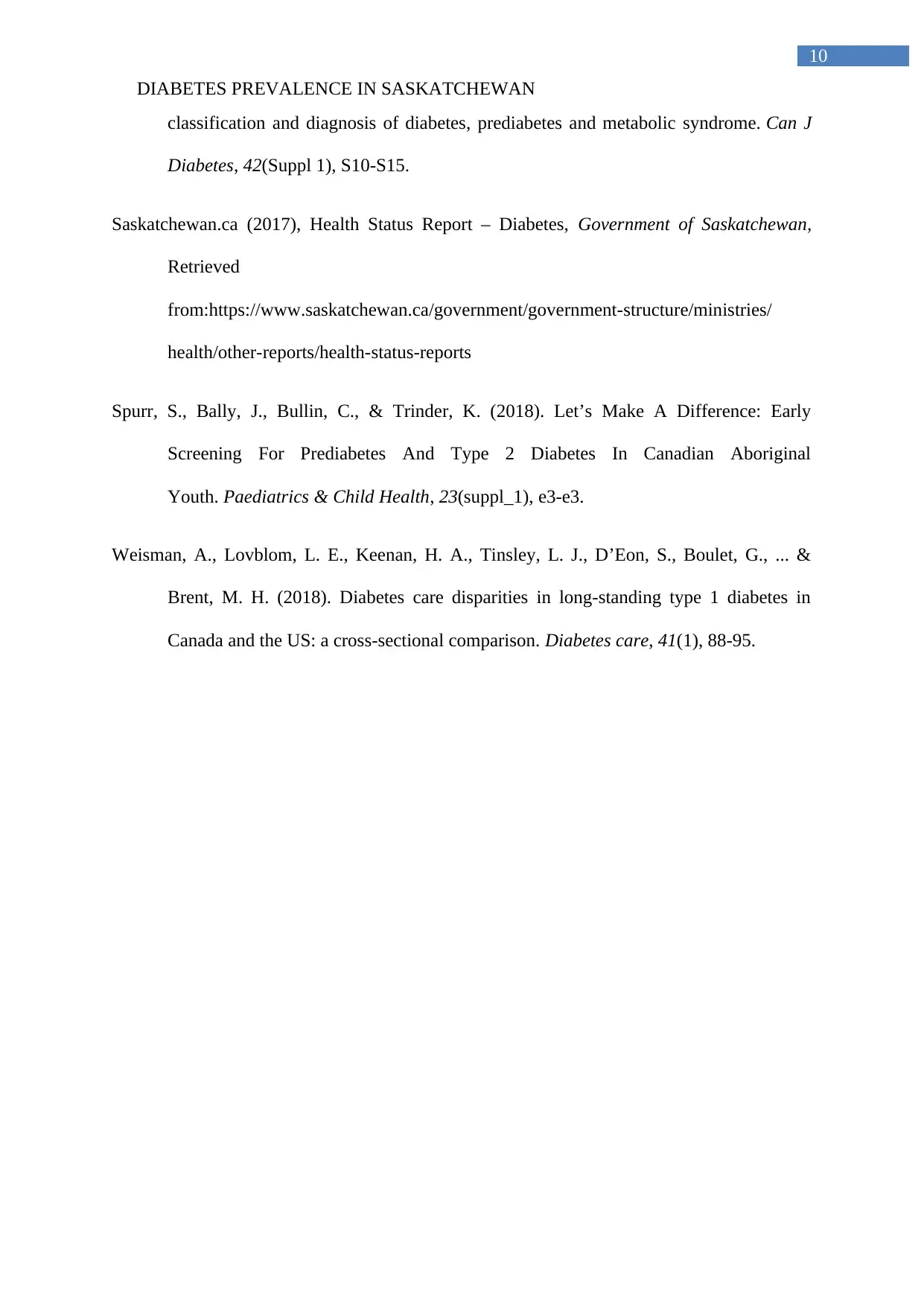
10
DIABETES PREVALENCE IN SASKATCHEWAN
classification and diagnosis of diabetes, prediabetes and metabolic syndrome. Can J
Diabetes, 42(Suppl 1), S10-S15.
Saskatchewan.ca (2017), Health Status Report – Diabetes, Government of Saskatchewan,
Retrieved
from:https://www.saskatchewan.ca/government/government-structure/ministries/
health/other-reports/health-status-reports
Spurr, S., Bally, J., Bullin, C., & Trinder, K. (2018). Let’s Make A Difference: Early
Screening For Prediabetes And Type 2 Diabetes In Canadian Aboriginal
Youth. Paediatrics & Child Health, 23(suppl_1), e3-e3.
Weisman, A., Lovblom, L. E., Keenan, H. A., Tinsley, L. J., D’Eon, S., Boulet, G., ... &
Brent, M. H. (2018). Diabetes care disparities in long-standing type 1 diabetes in
Canada and the US: a cross-sectional comparison. Diabetes care, 41(1), 88-95.
DIABETES PREVALENCE IN SASKATCHEWAN
classification and diagnosis of diabetes, prediabetes and metabolic syndrome. Can J
Diabetes, 42(Suppl 1), S10-S15.
Saskatchewan.ca (2017), Health Status Report – Diabetes, Government of Saskatchewan,
Retrieved
from:https://www.saskatchewan.ca/government/government-structure/ministries/
health/other-reports/health-status-reports
Spurr, S., Bally, J., Bullin, C., & Trinder, K. (2018). Let’s Make A Difference: Early
Screening For Prediabetes And Type 2 Diabetes In Canadian Aboriginal
Youth. Paediatrics & Child Health, 23(suppl_1), e3-e3.
Weisman, A., Lovblom, L. E., Keenan, H. A., Tinsley, L. J., D’Eon, S., Boulet, G., ... &
Brent, M. H. (2018). Diabetes care disparities in long-standing type 1 diabetes in
Canada and the US: a cross-sectional comparison. Diabetes care, 41(1), 88-95.
1 out of 11
Related Documents
Your All-in-One AI-Powered Toolkit for Academic Success.
+13062052269
info@desklib.com
Available 24*7 on WhatsApp / Email
![[object Object]](/_next/static/media/star-bottom.7253800d.svg)
Unlock your academic potential
© 2024 | Zucol Services PVT LTD | All rights reserved.





